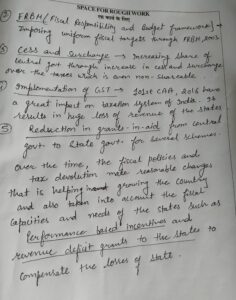Roadmap for Answer Writing Introduction Define federalism and its significance in the context of the Indian Constitution. Introduce the concept of “quasi-federalism,” highlighting the dual nature of the Constitution that combines federal and unitary features. State the thesis: While federalism is a fundamental principle, ...
The President of India Cannot Become a Dictator: Explanation 1. Constitutional Framework: The Indian Constitution restricts the President's powers to prevent dictatorial rule. The President's role is largely ceremonial and executive functions are carried out based on Prime Ministerial advice. 2. CheRead more
The President of India Cannot Become a Dictator: Explanation
1. Constitutional Framework:
The Indian Constitution restricts the President’s powers to prevent dictatorial rule. The President’s role is largely ceremonial and executive functions are carried out based on Prime Ministerial advice.
2. Checks and Balances:
The Prime Minister and Council of Ministers are accountable to the Parliament, not the President. The President cannot act unilaterally or overrule the decisions of the government.
3. Recent Examples:
In 2018, President Ram Nath Kovind did not intervene in the Kerala Assembly resolution against the Supreme Court’s Sabarimala verdict, demonstrating adherence to the Constitutional limits.
4. Impeachment:
The President can be removed through an impeachment process involving both Houses of Parliament, ensuring democratic control over the office.
In conclusion, the President’s powers are limited and regulated by the Constitution, preventing any dictatorial tendencies.
See less


Model Answer The Indian Constitution is often characterized as "quasi-federal" due to its unique blend of federal and unitary features. While it establishes a federal structure, it predominantly favors a strong central government, which raises concerns about the strength of federalism. Features FavoRead more
Model Answer
The Indian Constitution is often characterized as “quasi-federal” due to its unique blend of federal and unitary features. While it establishes a federal structure, it predominantly favors a strong central government, which raises concerns about the strength of federalism.
Features Favoring a Strong Centre
Division of Powers
The Constitution delineates powers between the Centre and the States through three lists: the Union List, the State List, and the Concurrent List (Article 246). The Union List contains subjects of national importance, such as defense and atomic energy, where only the Centre can legislate. In contrast, conflicts arising in the Concurrent List favor Central laws over State laws (Article 254), undermining state autonomy.
Emergency Powers
The Centre possesses extensive emergency powers under Articles 352, 356, and 360. During a national emergency, the Centre can legislate on State List subjects, and President’s Rule can be imposed, transferring state powers to the Centre. This has led to criticisms of misuse, especially against opposition-led states.
All-India Services
The Constitution establishes All-India Services, such as the IAS and IPS (Article 312), which are recruited and trained by the Centre but serve in the States. This fosters uniformity and allows the Centre to exert control over state administration.
Role of the Governor
Governors, appointed by the President, hold discretionary powers, including reserving bills for the President’s consideration. Critics argue this role often leans towards central interests, undermining state authority.
Financial Relations
The Centre has greater control over financial resources (Articles 268-293), often leaving States with limited bargaining power in revenue distribution. This financial dependency further weakens state autonomy.
Conclusion
While the Indian Constitution embodies a federal structure, its unitary features are designed to ensure national unity and effective governance. The challenge lies in maintaining a balance that prevents the centralization of power while respecting state autonomy. The evolution of cooperative federalism, as seen in bodies like the GST Council, illustrates the potential for collaboration between the Centre and States, promoting a more equitable federal system.
See less